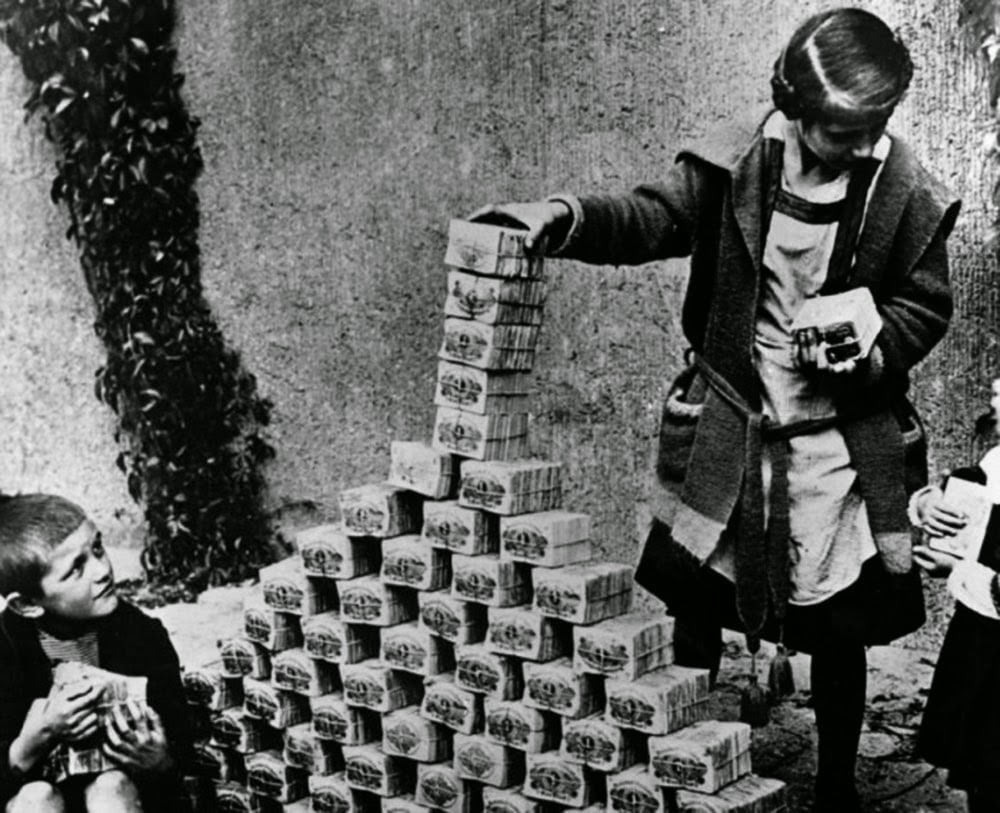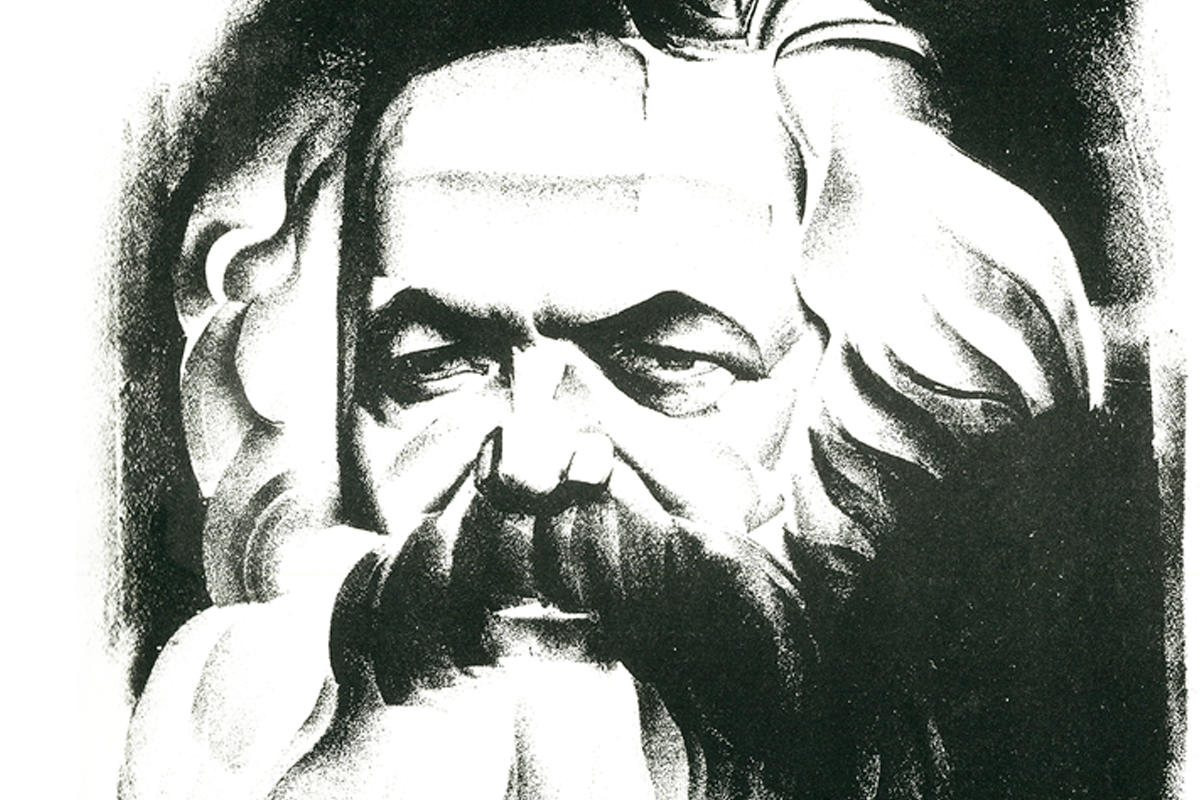In the fourth part of his series on the history and development of money, Adam Booth examines the factors lying behind inflation and explores the role of gold as the basis for an international monetary system. As the collapse of the gold standard – and more recently the European single currency – demonstrate, the contradictions of capitalism will eventually always come to the fore.
[Read parts one, two, and three]
The scourge of inflation
Whilst minted coins may bear the faces of the heads of state with whose authority they have been issued, it is important to stress that this does not mean that money was ever “invented” or imposed from above. Rather, it is an emergent social device within a society where a market economy has developed, as Graeber emphasises:
“The reasons why anthropologists haven’t been able to come up with a simple, compelling story for the origins of money is because there’s no reason to believe there could be one. Money was no more ever ‘invented’ than music or mathematics or jewellery. What we call ‘money’ isn’t a ‘thing’ at all; it’s a way of comparing things mathematically…” (Graeber, op. cit. p52)
Although it is emergent, and not imposed or invented, the relations represented by money are nevertheless based on something that is objective and real – that is, the socially necessary labour time embodied within society’s total wealth of commodities in circulation.
The real wealth of a society, in other words, consists not in its accumulation of coins and cash, nor in bubbles of credit and debt, but in the level of the productive forces – and resultant use-values – at its disposal. Indeed, as discussed earlier, many a regime or ruler in history has been reminded of this fact when attempting to increase their wealth simply through debasement of the currency or printing money – a technique that universally leads to creating greater economic instability and ultimately, ironically, to the impoverishment of the society in question.
Whilst there is no apparent limit to the amount of money that can be put into circulation, then, it is nevertheless clear that this amount is not arbitrary. As explained earlier, money is above all a measure of value – the universal measure of value. The amount of money in circulation, therefore, must ultimately be linked to the total value of commodities in circulation – equivalent in money terms to the total of the prices – and to the speed (the velocity or turnover) with which this money exchanges hands. For example, all things being equal, if the quantity of commodities remains constant but the amount of notes in circulation doubles, then the price of each commodity will double also.
Inflation is a reflection of market forces: if the money supply increases, there will be a general increase in the demand for commodities, and thus a general rise in prices. Inflation of specific commodities can still occur in the absence of an increasing money supply, however; for example, as a result of a scarcity or restriction in the supply of certain goods, which pushes their price above their value. Similarly, if the costs of production for a particular commodity increase, i.e. there is an increase in its socially necessary labour time, these will be reflected in a relatively higher value and thus a newly inflated price for this commodity in relation to others.
A generalised inflation – that is, a general inflation in the price of all commodities – in society, then, can only take place as a result of an expansion of the money supply and a debasement (devaluation) of the currency; or as a product of a rise in the price of a commodity such as oil, which acts as an important factor in the cost of production for all other commodities.
As discussed earlier, money – both in terms of commodity money and credit money – is ultimately a set of social relations; an expression of the distribution of wealth within society. The role of such a generalised inflation, therefore, is to change the balance of these social relations and redistribute this wealth from one group to another: primarily in terms of a transfer of wealth from creditors to debtors, whose debts in real terms are diminished by inflation.
Since debasement and a generalised inflation ultimately acts to redistribute wealth, the question of who controls the money supply reflects itself historically as a struggle between the classes, as noted earlier in terms of the battle between feudal kings and the nascent bourgeoisie over the money supply. As Marx comments in Capital:
“The class struggle in the ancient world, for instance, took the form mainly of a contest between debtors and creditors, and ended in Rome with the ruin of the plebeian debts, who were replaced by slaves. In the Middle Ages the contest ended with the ruin of the feudal debtors, who lost their political power together with its economic basis. Here, indeed, the money-form – and the relation between creditor and debtor does have the form of a money-relation – was only the reflection of an antagonism which lay deeper, at the level of the economic conditions of existence.” (Marx, op. cit., p233)
What indebted workers might gain with one hand from a generalised inflation and a decrease in the real value of their debts, however, they risk losing with the other hand in the form of an erosion of the purchasing power of their wages. For if there is a general increase in prices, but without any corresponding increase in pay, then it is clear that workers will experience a decrease in their real wages – that is, a decrease in the quantity of goods that their wages can be exchanged for.
In the 1970s, the trade unions in Britain were blamed by bourgeois politicians and right-wing papers for causing high inflation, with claims that militant strikes demanding (and winning) “unreasonable” wage increases were leading to rising costs of production across the board. Such a narrative has become a popularised myth that continues to be propagated by the capitalist class and their political representatives in this day and age.
In fact, the reality was the other way around. Workers were generally fighting to increase their wages to catch up with inflation – inflation that arose due to other (international) factors, such as: the expansionist Keynesian policies enacted by all advanced capitalist countries throughout the post-war boom; the vast expenditure on military spending by the USA, who exported inflation across the world through the Bretton Woods monetary system; and the oil crisis of 1973, which saw energy prices soar.
The capitalists vehemently opposed such strikes over wages, knowing that a generalised wage increase for workers could only be achieved on the basis of a generalised reduction in their profits. Ted Grant explained this back in 1971 when responding to the slanders of the Tory government and bourgeois media:
“What causes price increases? If the capitalists could arbitrarily raise prices they would not wait for wages to rise. They are interested in gaining the maximum, profits. What stops them is competition, especially under modern conditions, nationally and internationally. In fact in general it is wages which lag behind prices and not vice-versa.
“If the capitalists could raise prices at their whim, why do they face the prospect of bitter strikes, with consequent loss of production and profits rather than concede the wage demands of the workers? If it was simply a question of passing on wage increases that would be the obvious way to solve the problem. But in fact the profit of the capitalist class is only the unpaid labour of the working class. Consequently an increase of wages for the workers, other things being equal, means a fall in the profit of the capitalists. Hence the cries of woe from the paid hacks of capitalism in the mass media.” (Ted Grant, The Truth Behind Inflation, Militant no. 71)
Today, the various capitalist governments around the world are resorting to unprecedentedly loose monetary policies in a desperate attempt to stimulate the economy, with all manner of previously unseen measures being implemented and proposed: from quantitative easing and negative interest rates, to talk of a “helicopter drop” of money directly into the pockets of consumers.
One would expect such policies to lead to rampant inflation across the board, but this has not occurred. Why? At root, the answer lies with the enormous level of overproduction that exists on a world scale, which reflects itself in a glut of commodities and “excess capacity” in all sectors, and which acts to put an enormous downward pressure on prices.
For example, unlike in the past – as a result of the slowdown in China, the massive expansion of the fracking industry in the USA, and the rivalry between producers such as Saudi Arabia and Iran – today oil prices have hit rock bottom. But rather than celebrating this fact, bourgeois politicians and economists are instead gravely concerned by the onset of deflation, which is a symptom of the system’s sickness.
In short, the market is saturated; capitalism has gone far beyond its limits; the development of the productive forces has come into conflict with the mode of production – that is, our ability to produce has come up against the barrier of private ownership and production for profit.
Monetary (in)stability
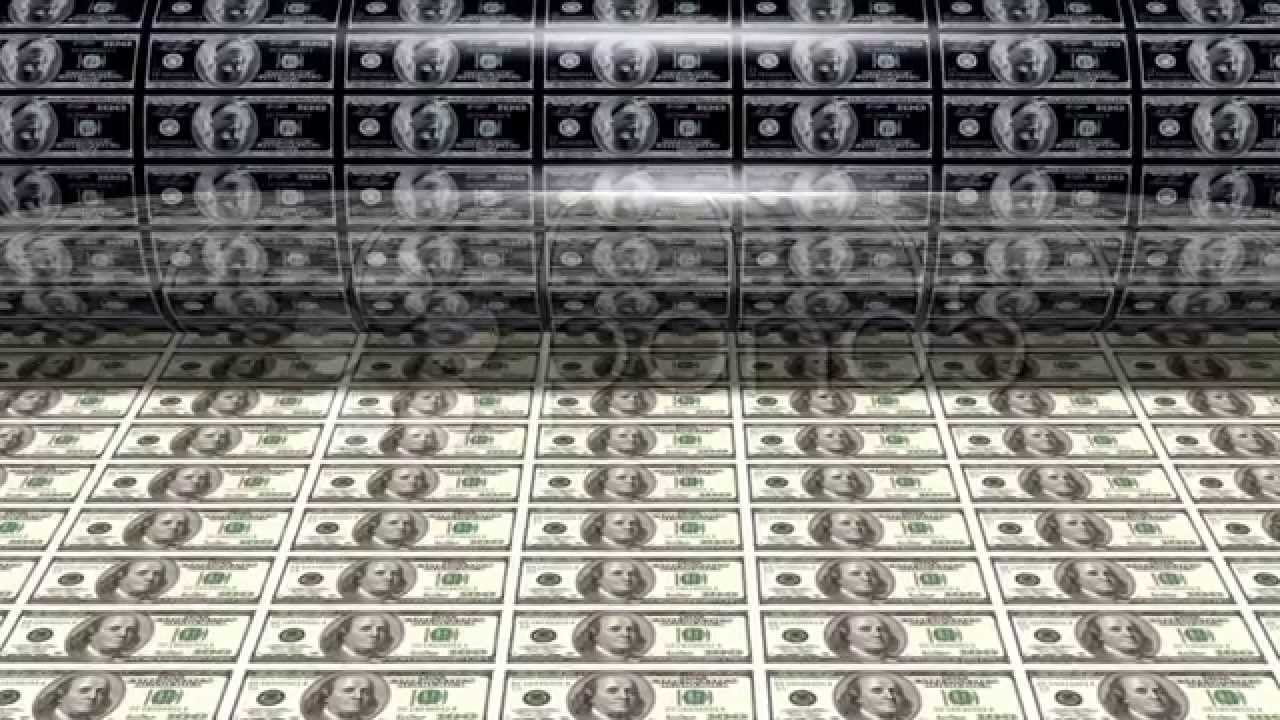 In theory, the money supply should remain anchored to the real economy by the demand for money. For example, if a business takes out a loan in order to invest and expand production, or if a family borrows in the form of a mortgage to buy a new house, then the creation of new money will be backed up by a corresponding increase of commodities in circulation.
In theory, the money supply should remain anchored to the real economy by the demand for money. For example, if a business takes out a loan in order to invest and expand production, or if a family borrows in the form of a mortgage to buy a new house, then the creation of new money will be backed up by a corresponding increase of commodities in circulation.
The reality, however, is not so simple. On the one hand, money acts as the lubricant to the whole flow of commodity production and exchange, enabling universal trade and exchange between individuals or communities who need never meet, and breaking up the act of exchange in both time and space. It thus provides movement and motion, dynamism and change. The rise of money, then, marks a powerful leap in the potential for the market – and thus for the forces of production – to expand.
On the other hand, the pressure exerted by the market to expand also calls forth a demand for a greater supply of money. Hence the development, as discussed earlier, of credit, banking, and finance. But it is within the nature of commodity production and exchange – that is, of private ownership – for this system to go beyond its limits. As discussed earlier, with the development of money and the rise of merchants and usurers, C-M-C is replaced by M-C-M’ (and M-M’); the end goal of production and exchange becomes further removed from fulfilling actual needs, and more and more about the accumulation of money.
This pressure for the money supply to expand is reflected in the tendency towards debasement, and in the evolution of money from coins whose value was equivalent to that of the precious metal contained within, to money in the form of banknotes, etc. which act as a mere representation, symbol, or token of value – a process that has reached its extreme in the modern age where a person’s wealth is represented by mere numbers on a screen.
Credit, then, acts to break the link between the real economy and the money supply. As discussed earlier, it allows for the productive forces to temporarily overcome the restrictions of the market. At the same time, it promotes all manner of speculation, resulting in a scourge of bubbles and fictitious capital. Prior to the financial crisis of 2007-08, for example, instead of households coming to the banks and asking for a loan, the banks came to households, encouraging them to join in with their orgy of credit creation in the form of subprime mortgages and credit cards. Meanwhile, the market carried on expanding and the capitalist system continued to grow on the basis of this house of cards, with big businesses able to realise their profits thanks to the artificial demand created by this credit.
In his book on Debt, David Graeber notes that the history of money has alternated between periods where the use of credit money has expanded and periods where the use of precious metals have tended to dominate. As noted earlier, for example, with the collapse of the Roman Empire came the breakdown of trade and banking, and thus a move away from credit towards a system of local and regional coinages, reflecting society’s dissolution at the time into feudal kingdoms and fiefdoms.
The collapse of the credit system and the reversion to commodity money (e.g. the precious metals), then, is a reflection of the general political and economic instability in society, which generates a craving for money that is tangible and not merely scribbles on a banker’s account book. As Graeber explains:
“…while credit systems tend to dominate in periods of relative social peace, or across networks of trust (whether created by states or, in most periods, transnational institutions like merchant guilds or communities of faith), in periods characterised by widespread war and plunder, they tend to be replaced by previous metal.” (Graber, op. cit., p214)
In this respect, the generally limited and stable amount of precious metals circulating around the world market – along with their advantageous material properties described earlier (homogeneity, durability, high value density, etc.) – helped to enforce their role as money, providing a reliable standard of prices, measure of wealth, and means by which debts could be transferred.
The use of precious metals as the money commodity does not guarantee the stability of prices, however. This was demonstrated by the example of the Spanish Empire in the 16th Century, where, after flooding the country with an abundance of gold and silver looted from their conquests of Central America, the rulers found themselves with an unstable situation of high inflation and low investment, which ultimately led to the collapse of the Spanish economy. “Everything is dear in Spain except silver,” one proverb from the time remarked. This fateful downfall again highlights the fact that it is not an abundance of money that makes a society rich, but rather the level of its productive forces and ability to produce real wealth.
Leon Trotsky also emphasised this point in respect to his analysis of the degeneration of the Soviet Union, where, under Stalin, an increase in the money supply was desperately and empirically used by the bureaucracy in an attempt to overcome the limits of the planned economy within conditions of economic isolation and backwardness.
Trotsky stressed that even with the establishment of the planned economy and the workers’ state, money would not lose its role as a measure of value until all last remnants of private ownership, commodity production and exchange, and class society had been abolished. In the meantime, Trotsky noted, any unchecked increase in the money supply would lead to a generalised inflation that would serve to limit the effectiveness of the planned economy. The question, again, is ultimately reduced to a question of the level of the productive forces available to society.
“These two problems, state and money, have a number of traits in common, for they both reduce themselves in the last analysis to the problem of problems: productivity of labor. State compulsion like money compulsion is an inheritance from the class society…
“The ruling circles were completely possessed by the opinion that with a planned economy inflation is not to be feared. This means approximately that if you possess a compass there is no danger in a leaking ship. In reality, currency inflation, inevitably producing a credit inflation, entails a substitution of fictitious for real magnitudes, and corrodes the planned economy from within. It is needless to say that inflation meant a dreadful tax upon the toiling masses.” (Leon Trotsky, The Revolution Betrayed, Chapter IV)
Today, whilst there has not been a general inflation as a result of loose monetary policies such as QE (for the reasons explained earlier), such measures have nevertheless given rise to an enormous instability within the world economy, with cheap money leaking abroad and inflating asset bubbles – for example, of housing and stocks, etc. – across the globe. The effect within those countries that have enacted QE programmes, meanwhile, has been to weaken their currencies, helping to boost exports. In essence, it has become yet another new form of “beggar-thy-neighbour” economics.
The vast QE programmes undertaken in the USA, UK, Europe, and Japan, then, designed to bring about economic stability in this time of deep crisis, have – as demonstrated by the stock market panic in China and elsewhere – clearly resulted in the exact opposite. A temporary stabilisation for some has merely served to create further instability for the system as a whole. Meanwhile, despite these vast monetary injections, the economies of all the major capitalist powers remain stuck in the doldrums.
The value of money, therefore, whilst being a quantitative relational expression, is not arbitrary or accidental, but lies on an objective material basis: as a representation of the total values that exist in circulation within the economy. As the examples above clearly demonstrate, there is no such thing as an economic “free lunch”. This important fact has equally important consequences, particularly in relation to the issue of inflation and the money supply that we see today.
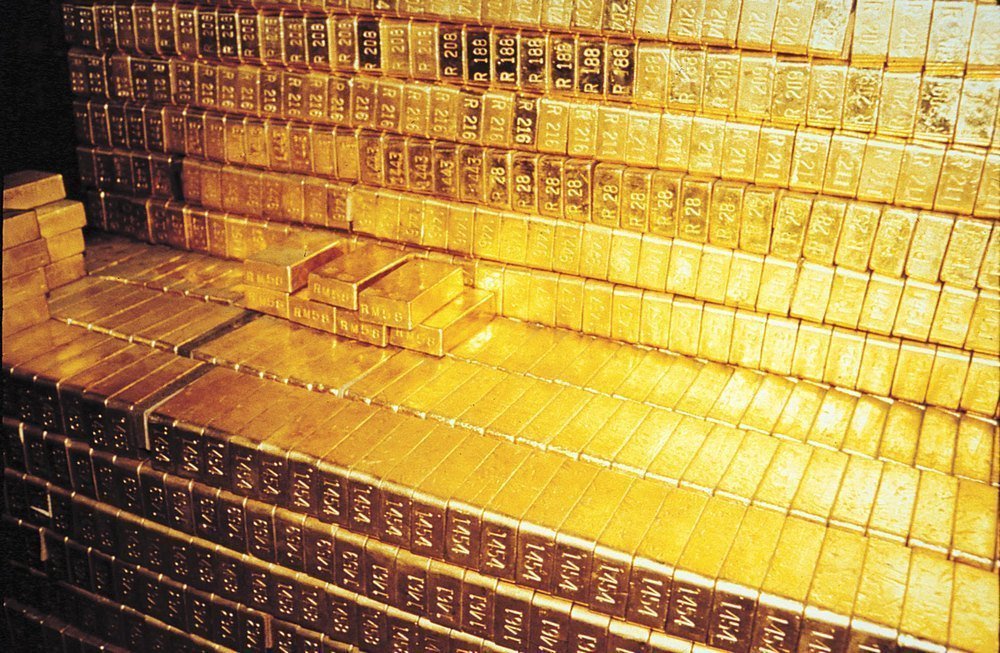
As good as gold
The use of a gold standard emerged historically as a reaction to loose monetary policies, in an attempt to anchor the money supply to something tangible. In Britain, the gold standard was brought in during the first half of the 19th century, in an attempt to combat the inflation seen as a result of the Napoleonic Wars, which had been funded through a massive increase in government debt. This culminated in the 1844 Bank Charter Act, which worked to restrict the money supply by giving the Bank of England a monopoly on the printing of new notes; these notes, in turn, had to be backed up by gold. Nevertheless, fractional reserve banking was maintained, allowing private banks to increase the money supply by creating new bank deposits (i.e. credit) in response to demands for loans.
With the rise and spread of the British Empire, an epoch of stability was created globally that allowed for the expansion of world trade and the emergence of the gold standard as an international monetary system. When capitalism was in its ascendency and the global economy was moving forward, the international gold standard acted a positive force, facilitating international trade by providing a universal comparison of prices in different countries, each with their own national currency.
As the contradictions within the capitalist system accumulated, however, the benefits provided by the international gold standard turned into their opposite and became yet another source of great instability within the volatile world economy. The beginning of World War One represented the global capitalist system reaching its limits, with the various imperialist powers coming into conflict with one another as they attempted to carve up and redivide the saturated world market. In turn, the onset of the Great War led to one country after another abandoning the gold standard as they attempted to fund their war efforts by printing money.
At the same time, the international gold standard acted to rigidly bind the various national economies together, restricting their ability to pursue currency devaluations in response to large balance of payments deficits. Instead, countries with poor trade balances were forced to carry out an “internal devaluation” – that is, an attack on workers’ wages and conditions, in order to improve the country’s economic competitiveness.
This was the position facing Britain after the war, whose position on the world stage had deteriorated to the extent that it could not return to the gold standard without an outright assault against the working class. Indeed, it was the implementation of such an assault by the British ruling class that led to the outbreak of the country’s first (and only) general strike in 1926, as the capitalists looked to regain their competitiveness by attacking wages – in particular, those of the miners.
When world trade was expanding and the economy was growing, the tensions and antagonisms between the various capitalist countries could be glossed over. But as the global economy entered into crisis and different national economies began moving in different directions, all the contradictions came to the fore.
After a brief return and window of stability in the 1920s, the international gold standard eventually collapsed and died with the onset of the Great Depression in 1929, which again forced country after country to abandon the gold standard as they attempted to pursue expansionist and inflationary monetary policies to stimulate the economy, fund government deficits, and provide liquidity to failing banks. A wave of protectionism and competitive devaluations swept across the world as each capitalist nation sought to export the crisis through “beggar thy neighbour” policies – a process that merely intensified the crisis on a world scale, as international trade collapsed and markets shrank.
The single currency
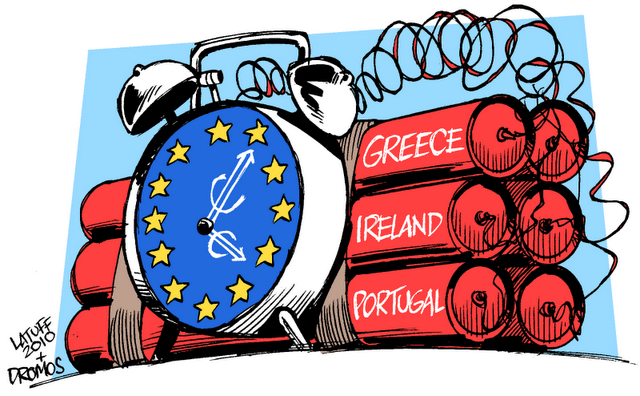 The parallels with today’s euro crisis – where the straightjacket of the single currency has served to heighten the contradictions within European capitalism – are plain to see. Once again, the weaker European economies such as Greece, Spain, and Portugal have been forced along the path of “internal devaluation”, which manifests itself in the shape of permanent cuts and attacks on workers; an attempt to bring Chinese working conditions to the shores of Europe. This is the real meaning of austerity today.
The parallels with today’s euro crisis – where the straightjacket of the single currency has served to heighten the contradictions within European capitalism – are plain to see. Once again, the weaker European economies such as Greece, Spain, and Portugal have been forced along the path of “internal devaluation”, which manifests itself in the shape of permanent cuts and attacks on workers; an attempt to bring Chinese working conditions to the shores of Europe. This is the real meaning of austerity today.
Such countries are told that they must become competitive in order to export. “We must be more like Germany and China!”; “we must invest, be more competitive, and export!” But not everyone can be like Germany and China. One only needs to ask the simple question of: export to whom? At a time when governments everywhere are carrying out austerity, where is there the demand for increased imports?
Furthermore, every country’s capitalists and political representatives are attempting to do the same thing, and – by definition – not everyone can be a net exporter. International competitiveness is fundamentally no different from the competition between different capitalist firms: under capitalism there will always be winners and losers. Imbalances and instability are inherent within the system.
Not everyone can be the most competitive. Competitiveness is always relative. The main difference is that in the competition between firms, weak firms will go under and will be subsumed by the stronger ones; on the international plane, less competitive national economies cannot be so simply assimilated – although that, in essence, is what “ever-closer union” inside the eurozone and the European Union has come to mean: a single economic zone in which the weaker economies are placed under the direct control of the stronger ones – i.e. of German capitalism.
At the same time, however, it must be stressed that, in both the case of the gold standard and the euro, the root cause of the problem is not the monetary system but the capitalist system. Inside or outside of the euro, the problems facing Greece, Spain, Ireland, Italy, and Portugal, for example, will not be solved as long as the laws of capitalism remain in place. It is the contradictions of capitalism – with its barriers of private ownership and the nation state – that have created the crisis; the international monetary system in place merely provides the form in which this crisis expresses itself.
Similarly, today there are those who imagine that a return to the gold standard – that is, to a system whereby currencies are pegged to a fixed quantity of gold – would be an infallible defence against the dangers of inflationary monetary policies, global trade imbalances, speculative bubbles, over-expanded credit, financial crises, and so on and so forth. But the gold standard is not a panacea. Ultimately the needs of commodity production and exchange impose themselves; the need for a greater circulation of money arises; and the rigid link between the money supply and a single commodity – be it gold or anything else – becomes a barrier to the growth of the capitalist economy and the development of the productive forces. This is what forced the development from coins of gold and silver – known as a gold specie standard – to a monetary system of paper notes backed up by gold; and this is what has led to abandonment of the gold standard altogether today.
Following the abandonment of the gold standard and the crisis of the Great Depression and the Second World War, an international monetary system was restored in 1944 in the form of the Bretton Woods system. Like the international gold standard, the fundamental basis for Bretton Woods was the growth and stability of the world economy, and the dominance of one global imperialist power – in this case, the USA, which emerged from WWII as the world capitalist superpower.
Under the new agreement, national currencies were fixed against the US Dollar, which in turn was “as good as gold” due to the fact that two-thirds of the world’s gold lay in the vaults of Fort Knox. Again, like with the gold standard in the 19th century, the Bretton Woods system helped facilitate the expansion of world trade, which in turn provided a powerful motor force to the post-war boom.
As the relative strength of US capitalism declined, however, the balance of payments between America and the rest of world deteriorated. Meanwhile, vast sums of money were being spent on the Vietnam War, funded through government borrowing. With the currencies of all countries tied to the dollar, the result was that American inflation was exported across the rest of the world.
The system of fixed exchange rates, as with the British adherence to an overvalued gold standard in the 1920s, or with the Greek economy in relation to the euro today, became politically impossible in the wake of declining competitiveness. Instead of devaluation, under a fixed exchange rate, workers were forced to pay for the competitiveness of their national economies by accepting wages cuts. The tensions and strains became unsustainable, and eventually the dollar-gold peg broke, bringing the Bretton Woods system down with it.
Today, with the deepest crisis in the history of capitalism, in place of stability, we face a world of unprecedented turbulence and volatility at every level: economically, politically, and socially. This has exposed all the contradictions within society and shattered any hope of returning to the temporary equilibrium established in the post-war period. Gone are the aspirations of peace and prosperity; in their place, we see instead a plague of wars and terrorist atrocities. The dream of “ever-closer union” in Europe has become a laughable joke, with the euro and the European Union both facing an existential crisis.
The central banks have resorted to the desperate measure of “quantitative easing” – central banks acting to buy up financial assets and thereby increase the money supply. As noted earlier, however, QE has not led to higher inflation; instead, it has simply added to the instability of the global economy, with this cheap money flooding markets and inflating speculative bubbles, particularly in emerging economies. Again, this comes back to the fundamental question regarding the monetary supply: the money in circulation must have a material basis – ultimately, a basis in terms of the real value – i.e. socially necessary labour time – embodied within the commodities in circulation in the economy.
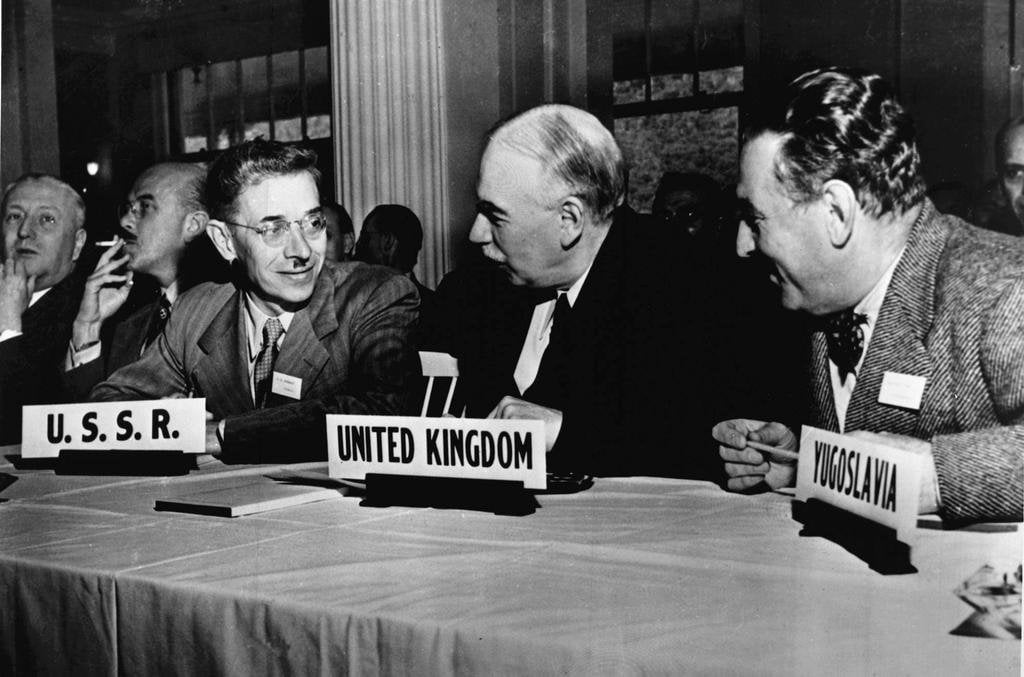
John Maynard Keynes (centre) at the Bretton Woods conference in 1944

